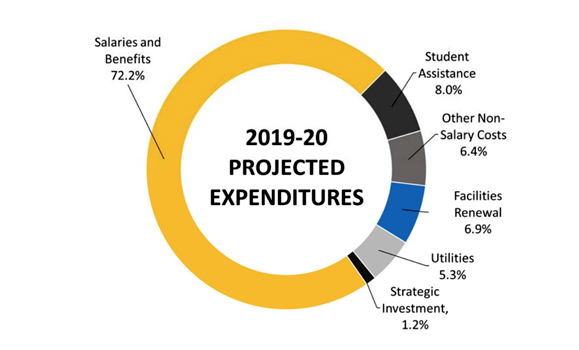π˙√Ò≤ ∆±‚Äôs Budget Advisory Committee (BAC) has released its draft plan for the 2020-21 operating budget ‚Äî a plan that aims to ensure financial responsibility while also advancing Dal‚Äôs core mission and priorities.
With revenues and expenditures balanced at $469.9M, the plan — which is tentative pending further input from the university community — makes new investments in priority areas identified in the BAC’s consultations with students, faculty and staff. These include student assistance, facilities renewal, classroom technology and the pool of funding available for strategic initiatives.
It also includes measures to address the core budget challenge π˙√Ò≤ ∆± faces each year: that costs increase at a faster rate than government funding does, leaving tuition (which makes up the bulk of the remainder of the operating budget) as the primary tool available to Dal to balance the budget and fund its priorities.
Read the full budget plan and tuition recommendations: dal.ca/budget
“Our success as a university requires investment in our people, our services and supports, our Faculties and facilities, and all aspects of our academic mission,” says Provost Teri Balser, who chairs the BAC. “That’s what the operating budget aims to do.”
Moving Dal’s academic mission forward
The Budget Advisory Committee (BAC) is a group chaired by the Provost, with members of senior leadership, faculty, staff and students. The BAC leads Dal’s transparent and consultative budget planning process, preparing high-level recommendations for how funding should be allocated across the university. It’s then up to leadership in each Faculty or service/support unit — deans, directors and AVPs — to determine how best to allocate those resources to deliver on their plans and ensure Dal’s strategic goals are achieved.

Most of the operating budget — over 72% — is spent on salaries, benefits and pension payments (“total compensation”) to faculty and staff. That leaves 28% or so of the budget (roughly $132M) to cover a wide range of other university priorities: general expenses for Faculties and service/support units, scholarships and bursaries, utility costs, facilities maintenance and classroom upgrades, IT requirements and more. And most of these costs increase each year.
Read also: Behind the budget: Revenues and expenses (Feb 21)
The BAC draft plan estimates that, including compensation, Faculty and service/support unit costs will go up by 3.9% in 2020-21. In contrast, Dal’s government grant, which makes up just under half of the operating budget, only increases 1% each year, as outlined in the Memorandum of Understanding (MOU) between Nova Scotia’s universities and the provincial government.
‚ÄúBecause resources are limited, we need to be focused, smart, and strategic in where we invest,‚Äù writes the BAC in its report. ‚ÄúThe budget must balance, but we also need to ensure that π˙√Ò≤ ∆± continues to thrive ‚Äî that we‚Äôre supporting our students, our faculty and our staff to move our academic mission forward.‚Äù
Some of the ways the budget plan proposes to do

